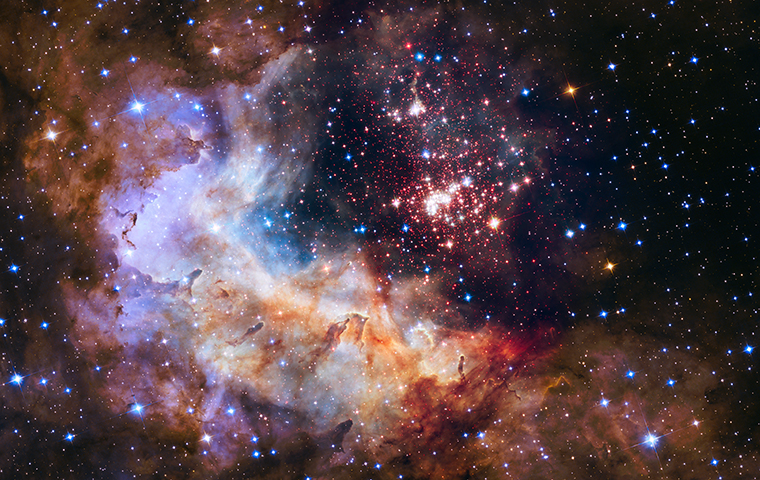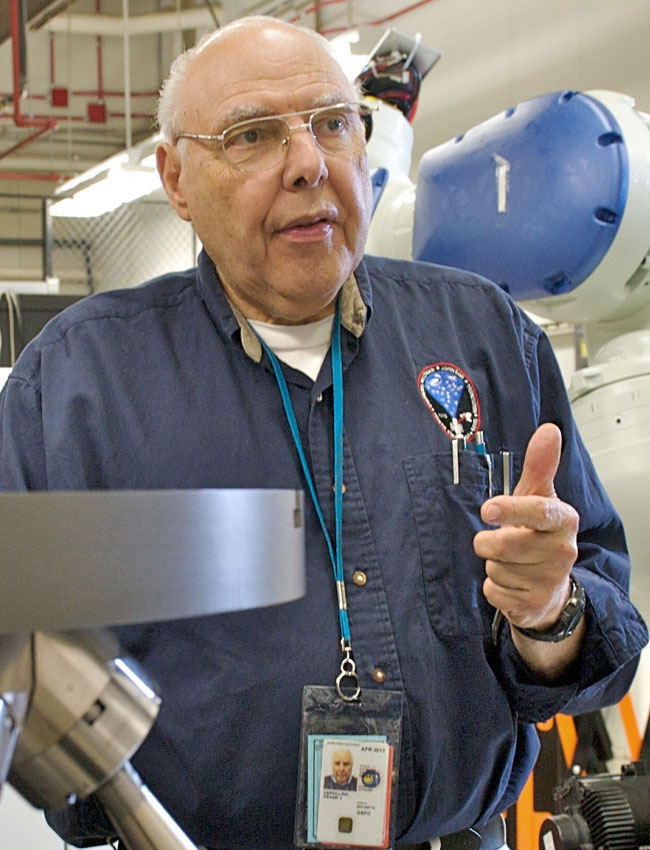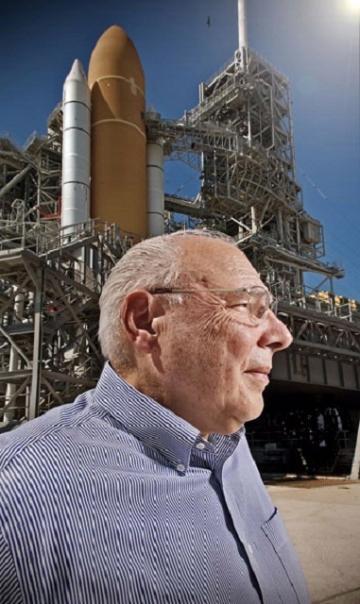
Hubble’s Mr. Fix-It Engineers Generous Gift
Solving urgent problems is part of the family legacy for Frank J. “Cepi” Cepollina ’59.
You might say Frank J. “Cepi” Cepollina’s groundbreaking work that enabled NASA to repair satellites in orbit—earning him the nickname Mr. Fix-It—stems from a family trait of solving urgent problems.
Family tradition also explains his penchant for giving back.
This fall, 20 years after establishing the Frank Cepollina Family Endowed Scholarship for undergraduate engineering students, the NASA retiree increased his commitment to the fund with a generous bequest intention from his estate that will expand affordability and accessibility to even more Santa Clara University engineering students.
“The essence of what SCU brought to me was the spirit of innovation,” says Cepollina, a new member of the University’s Thomas I. Bergin Legacy Society.
“We must focus on maintaining within students that spirit to come up with solutions that have never been thought of before.”
Never taking no for an answer
Growing up in Castro Valley, Cepollina had taught himself how to solve mechanical problems while working on his grandfather’s tractors. That’s where he also learned an important lesson that would serve him well, especially after joining NASA’s Goddard Space Flight Center in Maryland in 1963: problems can give rise to opportunities.
On April 9, 1984, NASA had a big problem.
Astronauts from the space shuttle Challenger were trying to capture and repair Solar Max, a failed solar research satellite.
For years, despite his bosses’ skepticism, Cepi had promoted the idea that spacecraft in orbit could be repaired by robotics and humans. After all, he reasoned, the cost of building a new satellite would be far more than fixing the Solar Max in orbit.
That day, Cepollina saw that the satellite was spinning too fast for the shuttle’s robot arm to grab it. The spinning also prevented the spacecraft’s solar panels from catching sunlight, meaning its batteries would die within 12 hours. On top of that, a software error had surfaced. Cepi’s dreams were about to shatter.
Somehow, engineers managed to upload new software, allowing the satellite to move into daylight for 10 minutes—enough to re-energize the batteries of the solar panels. The next day, the astronauts not only repaired the satellite, they installed new electronics.
Yet that was nothing compared to the complexity and difficulty Cepollina and his team faced in 1993, when astronauts had to repair the Hubble Space Telescope, the most successful scientific instrument ever launched into space. The SCU-trained engineer would oversee four more HST in-orbit repair and upgrade missions, and what was once deemed impossible is now considered almost routine. For his achievements, Cepollina was inducted into the National Inventors Hall of Fame in 2003.
“It was all those years of training, the indoctrination of never taking no for a final answer,” recalls the 83-year-old, who has at least six U.S. patents bearing his name.

Frank Cepollina at work at NASA’s Goddard Space Flight Center in Maryland.
A boy and his tractors
His grandfather’s broken tractors had started it all.
“I would tear them apart to figure out how they worked, what was broken, and some practical way of keeping the tractor running,” says Cepollina.
Meanwhile, his electric model train—he remains an O-gauge train buff to this day—taught him the fundamentals of electrical engineering.
The chance to learn more about the way things worked led him to enroll at Santa Clara University as a mechanical engineering major.
It wasn’t easy.
“The only way I made it was by studying my tail off day and night,” he recalls of the grueling coursework. “It formed within me a philosophy that says nothing is impossible if you try hard enough.”
By his senior year, the Space Race with the Soviet Union had already begun. While working on his senior thesis on hot water rocketry, SCU’s chair of mechanical engineering arranged for Cepollina to attend a preview of the latest advances in the rocket science, just nine miles up the road at Lockheed Martin.
A heritage of risk and reward
An exciting new world had opened up for Cepollina, who in 1963 joined NASA. Though he retired in 2017, he continues to work as a consultant.
“The greatest part of engineering is the first four to six years after students graduate from college, the most creative time they will have in their lifetimes,” says the first son in the Cepollina family to attend college, and the proud grandson of immigrants.
Like millions of other newcomers in the 1890s, his grandfather Giobatta Cepollina had left Europe, specifically northern Italy, for a better life in the U.S. By the time he settled down in Alameda, he was a farmer growing artichokes, tomatoes, lettuce, and onions. What started as a job delivering his produce to customers around the East Bay soon expanded to hauling garbage from their homes.
To do that, Cepollina needed three more horses and wagons—and a loan from fellow Italian A.P. Giannini, who founded the Bank of Italy in San Francisco in 1904. Their meeting proved to be propitious.
When the pre-dawn earthquake struck San Francisco in 1906, the bank building collapsed. But it wasn’t the rubble Giannini worried about: it was the devastating fires that followed, eventually destroying 28,000 buildings. Quickly realizing he had to move the bank’s money outside the burning city, Giannini contacted Cepollina to help him haul as much of the bank’s $2 million that he could carry in his garbage wagons, hidden under refuse. As a result, Giannini was soon able to open his bank after the historic disaster, and help rebuild the city.
“My grandmother begged him not to do it,” recalls Cepi. “The whole city was on fire. But it was his friend who had lent him the money to start his business.”
In appreciation, Giannini gave Cepi’s then-teenage father a job at the bank. Years later, after retiring from what had become the Bank of America, Frank Cepollina Sr. bought a nearly bankrupt French bakery, turned it around, and sold it to the renown Toscana Bakery in Oakland. His business savvy in the industry earned the admiration of General Mills, which hired him as a consultant to work with other Bay Area bakeries that were struggling.

Cepollina's love of rocket science started at SCU. Photo courtesy of the Smithsonian Institution.
Serendipity, and the art of giving back
Like his father and grandfather before him, Cepollina was at the right place at the right time in life, and Santa Clara University had played a crucial role. (His love of SCU inspired one of his sons, Joseph Cepollina ‘95—married to Alyson Cepollina ‘94—to become a Bronco.)
His affection for his alma mater also shone in 1999, when Cepollina established the SCU endowed scholarship in his family’s name, fulfilling a commitment to his grandparents and parents, whose hard work and lifelong savings had paid for his education, and his sister’s at UC Berkeley.
Supporting SCU's Jesuit foundation and principles, a bedrock for Cepollina during his undergraduate years, was another goal.
“The professors and Jesuits at Santa Clara gave me the strength to put out the extra energy to study and survive, and make it through four years of engineering,” he says. “And I needed every bit of that, especially before exams.”
Through his estate gift to SCU, Cepollina is helping to prepare the next generation of engineers and inventors who might one day change the world.
“Kids today are so much smarter than we were—seniors in high school have taken half the courses we could have in college!” he says.
“That’s why it’s important to put these students together with SCU’s ‘hands-on’ professors, who can get them to focus on innovative kinds of things, and see what the students come up with.”
Photo of a giant cluster of about 3,000 stars called Westerlund 2, captured by the Hubble Space Telescope. Photo Courtesy NASA